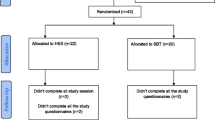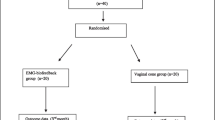Purpose
Pelvic floor rehabilitation is an appealing treatment for patients with fecal incontinence but reported results vary. This study was designed to assess the outcome of pelvic floor rehabilitation in a large series of consecutive patients with fecal incontinence caused by different etiologies.
Methods
A total of 281 patients (252 females) were included. Data about medical history, anal manometry, rectal capacity measurement, and endoanal sonography were collected. Subgroups of patients were defined by anal sphincter complex integrity, and nature and possible underlying causes of fecal incontinence. Subsequently patients were referred for pelvic floor rehabilitation, comprising nine sessions of electric stimulation and pelvic floor muscle training with biofeedback. Pelvic floor rehabilitation outcome was documented with Vaizey score, anal manometry, and rectal capacity measurement findings.
Results
Vaizey score improved from baseline in 143 of 239 patients (60 percent), remained unchanged in 56 patients (23 percent), and deteriorated in 40 patients (17 percent). Mean Vaizey score reduced with 3.2 points (P < 0.001). A Vaizey score reduction of ≥ 50 percent was observed in 32 patients (13 percent). Mean squeeze pressure (+5.1 mmHg; P = 0.04) and maximal tolerated volume (+11 ml; P = 0.01) improved from baseline. Resting pressure (P = 0.22), sensory threshold (P = 0.52), and urge sensation (P = 0.06) remained unchanged. Subgroup analyses did not show substantial differences in effects of pelvic floor rehabilitation between subgroups.
Conclusions
Pelvic floor rehabilitation leads overall to a modest improvement in severity of fecal incontinence, squeeze pressure, and maximal tolerated volume. Only in a few patients, a substantial improvement of the baseline Vaizey score was observed. Further studies are needed to identify patients who most likely will benefit from pelvic floor rehabilitation.


Similar content being viewed by others
References
AK Macmillan AE Merrie RJ Marshall et al. (2004) ArticleTitleThe prevalence of fecal incontinence in community-dwelling adults: a systematic review of the literature Dis Colon Rectum 47 1341–1349 Occurrence Handle15484348 Occurrence Handle10.1007/s10350-004-0593-0
Incontinence. Proceedings of the Second International Consultation on Incontinence. Plymouth: Health Publication Lt, 2001.
RD Madoff SC Parker MG Varma et al. (2004) ArticleTitleFaecal incontinence in adults Lancet 364 621–632 Occurrence Handle15313364 Occurrence Handle10.1016/S0140-6736(04)16856-6
BT Engel P Nikoomanesh MM Schuster (1974) ArticleTitleOperant conditioning of rectosphincteric responses in the treatment of fecal incontinence N Engl J Med 290 646–649 Occurrence Handle4813725 Occurrence Handle1:STN:280:DyaE2c7gtlCqsQ%3D%3D Occurrence Handle10.1056/NEJM197403212901202
C Norton (2004) ArticleTitleBehavioral management of fecal incontinence in adults Gastroenterology 126 S64–S70 Occurrence Handle14978640 Occurrence Handle10.1053/j.gastro.2003.10.058
Hosker G, Norton C, Brazzelli M. Electrical stimulation for faecal incontinence in adults. Cochrane Database Syst Rev 2000;2:CD001310
Norton C, Hosker G, Brazzelli M. Biofeedback and/or sphincter exercises for the treatment of faecal incontinence in adults. Cochrane Database Syst Rev 2000;2:CD002111
C Norton MA Kamm (2001) ArticleTitleAnal sphincter biofeedback and pelvic floor exercises for faecal incontinence in adults: a systematic review Aliment Pharmacol Ther 15 1147–1154 Occurrence Handle11472317 Occurrence Handle1:STN:280:DC%2BD38%2FislSntg%3D%3D Occurrence Handle10.1046/j.1365-2036.2001.01039.x
P Beddy P Neary EI Eguare et al. (2004) ArticleTitleElectromyographic biofeedback can improve subjective and objective measures of fecal incontinence in the short term J Gastrointest Surg 8 64–72 Occurrence Handle14746837 Occurrence Handle10.1016/j.gassur.2003.10.005
MM Fynes K Marshall M Cassidy et al. (1999) ArticleTitleA prospective, randomized study comparing the effect of augmented biofeedback with sensory biofeedback alone on fecal incontinence after obstetric trauma Dis Colon Rectum 42 753–758 Occurrence Handle10378599 Occurrence Handle1:STN:280:DyaK1MzgsV2ntg%3D%3D Occurrence Handle10.1007/BF02236930
EP Lorenz A Wondzinski (1996) ArticleTitleResults of conservative and surgical therapy of anal incontinence. 1974 to 1992 patient sample Zentralbl Chir 121 669–675 Occurrence Handle8967214 Occurrence Handle1:STN:280:DyaK28vjsl2qsw%3D%3D
C Norton MA Kamm (1999) ArticleTitleOutcome of biofeedback for faecal incontinence Br J Surg 86 1159–1163 Occurrence Handle10504370 Occurrence Handle1:STN:280:DyaK1Mvjs1Kltg%3D%3D Occurrence Handle10.1046/j.1365-2168.1999.01215.x
JM Jorge A Habr-Gama SD Wexner (2003) ArticleTitleBiofeedback therapy in the colon and rectal practice Appl Psychophysiol Biofeedback 28 47–61 Occurrence Handle12737096 Occurrence Handle10.1023/A:1022316900628
CJ Vaizey E Carapeti JA Cahill et al. (1999) ArticleTitleProspective comparison of faecal incontinence grading systems Gut 44 77–80 Occurrence Handle9862829 Occurrence Handle1:STN:280:DyaK1M%2FotFKmuw%3D%3D Occurrence Handle10.1136/gut.44.1.77
SS Rao (2004) ArticleTitlePathophysiology of adult fecal incontinence Gastroenterology 126 S14–S22 Occurrence Handle14978634 Occurrence Handle10.1053/j.gastro.2003.10.013
EE Soffer T Hull (2000) ArticleTitleFecal incontinence: a practical approach to evaluation and treatment Am J Gastroenterol 95 1873–1880 Occurrence Handle10950029 Occurrence Handle1:STN:280:DC%2BD3cvhs1aluw%3D%3D Occurrence Handle10.1111/j.1572-0241.2000.02237.x
NE Diamant MA Kamm A Wald et al. (1999) ArticleTitleAGA technical review on anorectal testing techniques Gastroenterology 116 735–760 Occurrence Handle10029632 Occurrence Handle1:STN:280:DyaK1M7lsFaqsA%3D%3D Occurrence Handle10.1016/S0016-5085(99)70195-2
PJ Isherwood A Rane (2000) ArticleTitleComparative assessment of pelvic floor strength using a perineometer and digital examination BJOG 107 1007–1011 Occurrence Handle10955433 Occurrence Handle1:STN:280:DC%2BD3cvis1yrtA%3D%3D
J Laycock D Jerwood (2001) ArticleTitlePelvic floor muscle assessment: The PERFECT scheme Physiotherapy 87 631–642 Occurrence Handle10.1016/S0031-9406(05)61108-X
C Norton S Chelvanayagam J Wilson-Barnett et al. (2003) ArticleTitleRandomized controlled trial of biofeedback for fecal incontinence Gastroenterology 125 1320–1329 Occurrence Handle14598248 Occurrence Handle10.1016/j.gastro.2003.09.039
NN Baxter DA Rothenberger AC Lowry (2003) ArticleTitleMeasuring fecal incontinence Dis Colon Rectum 46 1591–1605 Occurrence Handle14668583
M Deutekom MP Terra AC Dobben et al. (2005) ArticleTitleImpact of faecal incontinence severity on health domains Colorectal Dis 7 263–269 Occurrence Handle15859965 Occurrence Handle1:STN:280:DC%2BD2M3isFantw%3D%3D Occurrence Handle10.1111/j.1463-1318.2005.00772.x
M Deutekom MP Terra AC Dobben et al. (2005) ArticleTitleSelecting an outcome measure for evaluating treatment in fecal incontinence Dis Colon Rectum 48 2294–2301 Occurrence Handle16400514 Occurrence Handle10.1007/s10350-005-0162-1
AE Bharucha (2004) ArticleTitleOutcome measures for fecal incontinence: anorectal structure and function Gastroenterology 126 S90–S98 Occurrence Handle14978644 Occurrence Handle10.1053/j.gastro.2003.10.014
BD Naliboff (2004) ArticleTitleChoosing outcome variables: global assessment and diaries Gastroenterology 126 S129–S134 Occurrence Handle14978649 Occurrence Handle10.1053/j.gastro.2003.10.011
ON Pamuk GE Pamuk AF Celik (2003) ArticleTitleRevalidation of description of constipation in terms of recall bias and visual scale analog questionnaire J Gastroenterol Hepatol 18 1417–1422 Occurrence Handle14675272 Occurrence Handle10.1046/j.1440-1746.2003.03155.x
AA Stone S Shiffman JE Schwartz et al. (2002) ArticleTitlePatient non-compliance with paper diaries BMJ 324 1193–1194 Occurrence Handle12016186 Occurrence Handle10.1136/bmj.324.7347.1193
R Bakx MA Sprangers FJ Oort et al. (2005) ArticleTitleDevelopment and validation of a colorectal functional outcome questionnaire Int J Colorectal Dis 20 126–136 Occurrence Handle15449078 Occurrence Handle10.1007/s00384-004-0638-9
AK Ryn GL Morren O Hallbook et al. (2000) ArticleTitleLong-term results of electromyographic biofeedback training for fecal incontinence Dis Colon Rectum 43 1262–1266 Occurrence Handle11005494 Occurrence Handle1:STN:280:DC%2BD3cvltVGisg%3D%3D Occurrence Handle10.1007/BF02237433
JO Keck RJ Staniunas JA Coller et al. (1994) ArticleTitleBiofeedback training is useful in fecal incontinence but disappointing in constipation Dis Colon Rectum 37 1271–76 Occurrence Handle7995157 Occurrence Handle1:STN:280:DyaK2M%2FoslCktw%3D%3D Occurrence Handle10.1007/BF02257795
RT Mahony PA Malone J Nalty et al. (2004) ArticleTitleRandomized clinical trial of intra-anal electromyographic biofeedback physiotherapy with intra-anal electromyographic biofeedback augmented with electrical stimulation of the anal sphincter in the early treatment of postpartum fecal incontinence Am J Obstet Gynecol 191 885–890 Occurrence Handle15467559 Occurrence Handle10.1016/j.ajog.2004.07.006
G Chiarioni G Bassotti S Stegagnini et al. (2002) ArticleTitleSensory retraining is key to biofeedback therapy for formed stool fecal incontinence Am J Gastroenterol 97 109–117 Occurrence Handle11808933 Occurrence Handle1:STN:280:DC%2BD38%2Fot1CktA%3D%3D Occurrence Handle10.1111/j.1572-0241.2002.05429.x
SK Patankar A Ferrara SW Larach et al. (1997) ArticleTitleElectromyographic assessment of biofeedback training for fecal incontinence and chronic constipation Dis Colon Rectum 40 907–911 Occurrence Handle9269806 Occurrence Handle1:STN:280:DyaK2svhtleqsw%3D%3D Occurrence Handle10.1007/BF02051197
SS Rao KD Welcher J Happel (1996) ArticleTitleCan biofeedback therapy improve anorectal function in fecal incontinence? Am J Gastroenterol 91 2360–2366 Occurrence Handle8931418 Occurrence Handle1:STN:280:DyaK2s%2FosFaktQ%3D%3D
A Glia M Gylin JE Akerlund et al. (1998) ArticleTitleBiofeedback training in patients with fecal incontinence Dis Colon Rectum 41 359–364 Occurrence Handle9514433 Occurrence Handle1:STN:280:DyaK1c7ntlelug%3D%3D Occurrence Handle10.1007/BF02237492
WF Tets Particlevan JH Kuijpers G Bleijenberg (1996) ArticleTitleBiofeedback treatment is ineffective in neurogenic fecal incontinence Dis Colon Rectum 39 992–994 Occurrence Handle8797647 Occurrence Handle10.1007/BF02054687
AM Leroi MP Dorival MF Lecouturier et al. (1999) ArticleTitlePudendal neuropathy and severity of incontinence but not presence of an anal sphincter defect may determine the response to biofeedback therapy in fecal incontinence Dis Colon Rectum 42 762–769 Occurrence Handle10378600 Occurrence Handle1:STN:280:DyaK1MzgsV2ntw%3D%3D Occurrence Handle10.1007/BF02236932
NA Rieger DA Wattchow RG Sarre et al. (1997) ArticleTitleProspective trial of pelvic floor retraining in patients with fecal incontinence Dis Colon Rectum 40 821–826 Occurrence Handle9221860 Occurrence Handle1:STN:280:DyaK2szmsV2isw%3D%3D Occurrence Handle10.1007/BF02055440
Acknowledgments
The authors thank the following participating investigators of our study group for scientific advice and collecting data: J. B. V. M. Delemarre, M.D., Ph.D.a; E. van der Harst, M.D., Ph.D.; P. P. L. O. Coene, M.D., Ph.D.; E. J. Spillenaar-Bilgen, M.D., Ph.D.; V. H. van der Vaart, M.D., Ph.D.; W. F. van Tets, M.D., Ph.D.; J. J. G. M. Gerritsen, M.D., Ph.D.; J. W. de Bruijne, M.D.; M. G. W. Dijkgraaf, Ph.D.; R. G. H. Beets-Tan, M.D., Ph.D.; V. P. M. van der Hulst, M.D., Ph.D.; T. G. Wiersma, M.D., Ph.D.; M. N. J. M. Wasser, M.D., Ph.D.; A. B. Huisman, M.D., Ph.D.; J. A. de Priester, M.D., Ph.D.; A. C. Sikkenk, M.D.; T. D. Witkamp, M.D. aDeceased.
Author information
Authors and Affiliations
Corresponding author
Additional information
Supported by grant 945-01-013 of the Netherlands Organization for Health Research and Development.
Reprints are not available.
About this article
Cite this article
Terra, M.P., Dobben, A.C., Berghmans, B. et al. Electrical Stimulation and Pelvic Floor Muscle Training With Biofeedback in Patients With Fecal Incontinence: A Cohort Study of 281 Patients. Dis Colon Rectum 49, 1149–1159 (2006). https://doi.org/10.1007/s10350-006-0569-3
Published:
Issue Date:
DOI: https://doi.org/10.1007/s10350-006-0569-3




